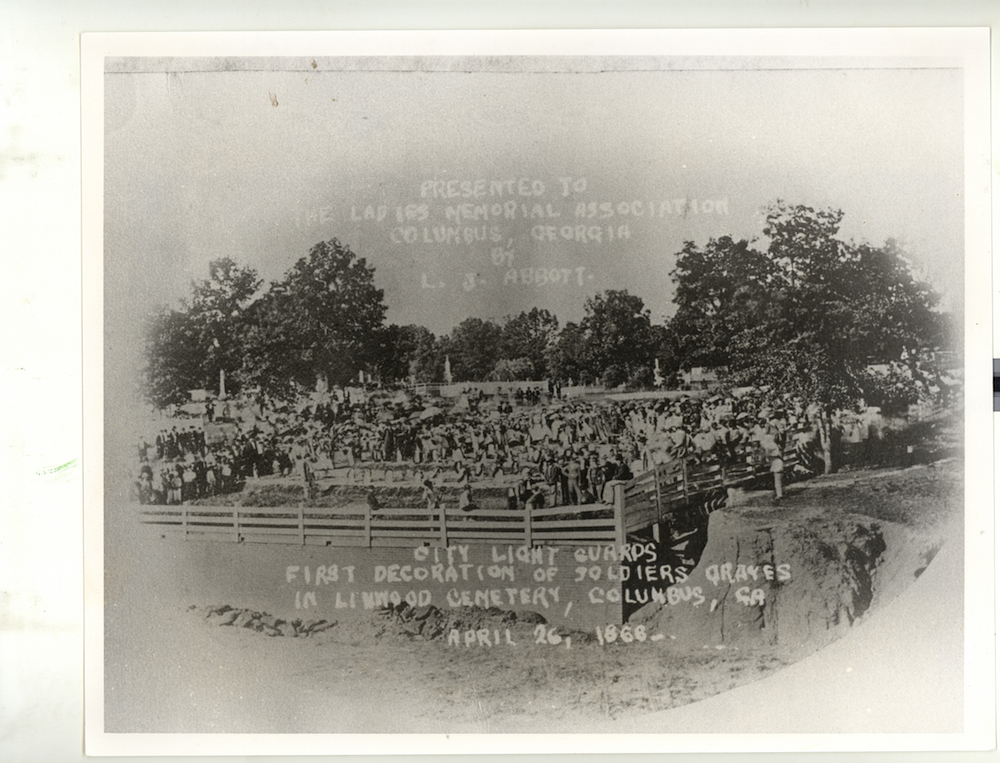The true story behind the 1st Memorial Day

Here's a trivia question for armchair historians: Was the first Memorial Day celebrated in Columbus, Georgia, or Columbus, Mississippi?
According to strict calendric interpretation, Columbus, Mississippi, celebrated the holiday first, on April 25, 1866, but only because newspaper editors fudged the date, said Richard Gardiner, an associate professor of history education at Columbus State University in Georgia, and co-author of "The Genesis of the Memorial Day Holiday" (Columbus State University, 2014).
Columbus, Georgia, where the concept of honoring the soldiers who died in the American Civil War originated, celebrated it a day later, on April 26, 1866, along with dozens of other cities, Gardiner said.
Related: 6 Civil War myths, busted
Columbus, Mississippi, may have celebrated Memorial Day first, but "what's not true is that they came up with the idea," Gardiner told Live Science.
In fact, there are many contenders for where Memorial Day started. Some say it started in Waterloo, New York, in 1866, and President Lyndon B. Johnson even signed a proclamation saying so in 1966. But historians have since discredited that claim, Gardiner said. Still, some people still trumpet the claim, including the village of Waterloo itself.
Here's why: In the 1880s, a reporter interviewed a source who thought that Waterloo celebrated the day in 1866, but the newspaper later ran a correction saying it was actually 1868. Still, not every newspaper that ran the story included the correction, leading some people to think that Waterloo was the first to celebrate the holiday that Americans call Memorial Day, Gardiner said.
Sign up for the Live Science daily newsletter now
Get the world’s most fascinating discoveries delivered straight to your inbox.
Others, including David Blight, a professor of history at Yale University, say the first Memorial Day happened in Charleston, South Carolina, according to The New York Times. On May 1, 1865, workmen honored and buried dead soldiers from the Union Army at a racetrack that had been turned into a war prison, Blight told The New York Times.
However, there's no evidence that this event sparked the national holiday, Gardiner said. People have honored dead soldiers and decorated their graves since the beginning of time, he added.
"It's not a question of who was the first person to decorate a grave," Gardiner said. "That does not create a holiday."
How Memorial Day started
Memorial Day's date has changed over the years, but the very first holiday was planned for April 26, 1866, in the wake of the American Civil War.
In January 1866, the Ladies' Memorial Association in Columbus, Georgia, passed a motion agreeing that they would designate a day to throw flowers on the graves of fallen soldiers buried at the cemetery, Gardiner said.
However, the ladies didn't want this to be an isolated event, so Mary Ann Williams, the group's secretary, wrote a letter and sent it to newspapers all over the United States.
"You'll find that letter in dozens of newspapers," Gardiner said. "It got out, and it was republished everywhere in the country."
In the letter, the ladies asked people to celebrate the war's fallen soldiers on April 26 — the day the bulk of Confederate soldiers surrendered in North Carolina in 1865.
"That's what many people in the South considered to be the end of the war," Gardiner said. Even though Gen. Robert E. Lee surrendered on April 9, "there were still 90,000 people ready to fight. And until those 90,000 surrendered on April 26, the war was effectively still going on," Gardiner said. [Album: Faces and Injuries of the Civil War]
But the date wasn't printed correctly in every newspaper, which led Columbus, Mississippi, to celebrate the holiday a day earlier, on April 25. Despite the mix-up, Columbus, Mississippi, is often credited as the birthplace of Memorial Day, Gardiner said.
In one of his 2010 weekly addresses, President Barack Obama said just that: "On April 25, 1866, about a year after the Civil War ended, a group of women visited a cemetery in Columbus, Mississippi, to place flowers by the graves of Confederate soldiers who had fallen at Shiloh," he said.
Gardiner said, "I don't contest that. But the evidence is abundantly clear that they were simply following what the newspaper had suggested that they do." Rather, it was the women of Columbus, Georgia, who thought of the idea, he said.
Flowers for all
On April 26, 1866, people across the South heeded Williams' letter and threw flowers on the graves of Civil War soldiers. Some Southern women noticed that Yankee graves, interspersed with the graves of their loved ones, sat untended, Gardiner said.
"They start to see these Union graves that are just laying there, kind of barren," he said. "Their hearts are warmed. Their hearts start to feel bad for the mothers who have lost these children. So, they start to throw flowers on the Yankee graves. And then that story gets published everywhere."
In the North, the poet Francis Miles Finch wrote "The Blue And the Gray," a poem that says, "They banish our anger forever/ When they laurel the graves of our dead!"
Many Southern women repeated the practice on April 26 in 1866 and 1867, and in 1868, "the story was just so strong and so well known that the authorities in the North said, 'Look, we've got to take this thing and make it national,'" Gardiner said.
In May 1868, the day became a federal holiday. But there were few, if any, flowers blooming in the North in April. So, the government pushed the date up a month, to May 30, so that people could decorate the graves of fallen soldiers with wildflowers, Gardiner said.
Memorial Day remained on May 30 until 1971, when the Uniform Monday Holiday Act took effect. This act mandated that federal holidays occur on Mondays, and made Memorial Day the last Monday in May, Gardiner said. [Mysterious Unclaimed Civil War Images]
As the holiday spread, people placed flowers on the graves of Confederate and Union soldiers, even if one had been a former enemy. For instance, in 1868, a girl named Jennie Vernon in Indiana sent a wreath with a letter to officials, asking that they lay flowers on a rebel soldier's grave, according to Gardiner .
"My dear papa is buried at Andersonville [Georgia], and perhaps some little girl will be kind enough to put a few flowers upon his grave," she wrote.
Long-standing debate
Memorial Day's many changes underwent scrutiny, however. When it became nationally recognized in 1868, some Northerners resisted, saying they shouldn't follow a Southern idea.
Likewise, some people in the South were upset that the North was "stealing" their idea, Gardiner said. That's why some Southerners still celebrate Memorial Day on April 26, he said.
But overall, the holiday has brought people together. Americans still honor it today, with celebrations and remembrances of people who have died fighting for their country, Gardiner said.
Original article on Live Science.

Laura is the archaeology and Life's Little Mysteries editor at Live Science. She also reports on general science, including paleontology. Her work has appeared in The New York Times, Scholastic, Popular Science and Spectrum, a site on autism research. She has won multiple awards from the Society of Professional Journalists and the Washington Newspaper Publishers Association for her reporting at a weekly newspaper near Seattle. Laura holds a bachelor's degree in English literature and psychology from Washington University in St. Louis and a master's degree in science writing from NYU.
